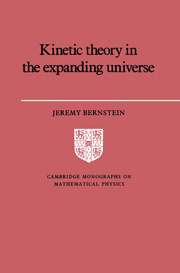Book contents
- Frontmatter
- Contents
- Preface
- 1 Tools: relativity
- 2 Tools: cosmodynamics
- 3 Tools: kinetic theory
- 4 The canonical example
- 5 The generalized Lee–Weinberg problem: background
- 6 The generalized Lee–Weinberg problem: examples
- 7 Unstable particles
- 8 The recombination regime
- 9 Cosmological helium production
- Appendix A
- Appendix B
- Appendix C
- Appendix D
- Appendix E
- References
- Index
- Frontmatter
- Contents
- Preface
- 1 Tools: relativity
- 2 Tools: cosmodynamics
- 3 Tools: kinetic theory
- 4 The canonical example
- 5 The generalized Lee–Weinberg problem: background
- 6 The generalized Lee–Weinberg problem: examples
- 7 Unstable particles
- 8 The recombination regime
- 9 Cosmological helium production
- Appendix A
- Appendix B
- Appendix C
- Appendix D
- Appendix E
- References
- Index
Summary
The purpose of this monograph is to provide a bridge between “two cultures.” On one side are mathematically inclined relativists such as J. M. Stewart (Stewart, 1971) and J. Ehlers (Ehlers, 1971), who have constructed the formal mathematics for kinetic theory in general relativity and on the other, the practical cosmologists who are concerned with physically interesting results obtained with a minimum of formalism. A partial bridge between these communities was erected by Weinberg (Weinberg, 1971, 1972). However, Weinberg's discussion focuses on macrophysics, ignoring for the most part the underlying microphysics. Our discussion will emphasize the microphysics. We will therefore be concerned with the solutions of the Boltzmann equations in the expanding universe for various cosmological processes. We will derive these equations from first principles and solve them as explicitly as possible. Many of the results will be familiar to practicing cosmologists but are presented here with more pedagogical rigor than is generally found in the literature. The treatment is meant to be essentially self-contained, but someone not familiar with the cosmological implications of general relativity would be advised to consult a book like that of Weinberg (Weinberg, 1972).
Now, by way of acknowledgment: My interest in this subject was first aroused by a series of informal lectures given by my Stevens Institute colleague J. L. Anderson (Anderson, 1970). I recall how surprised I was to learn that a Robertson–Walker universe did not, in general, admit equilibrium solutions to the Boltzmann equations (details are given later in the book).
- Type
- Chapter
- Information
- Kinetic Theory in the Expanding Universe , pp. vii - viiiPublisher: Cambridge University PressPrint publication year: 1988

